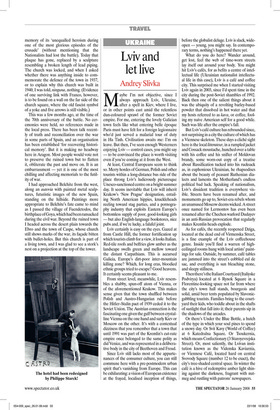Homage to Aragon
Simon Courtauld visits a battle-scarred memorial to the Spanish civil war For students of the Spanish civil war, and especially its battlefields, Aragon, visited by few foreign tourists, is the place to go. We are now in the 70th-anniversary years of that civil war. George Orwell was fighting briefly on the Aragon front near Huesca in 1937, and the battle of Teruel was grinding on, in one of the coldest winters ever recorded in Spain, 70 years ago this month. Laurie Lee wrote a personal account of his experiences of the battle in A Moment of War, but he in fact took no part in it. The following summer the trade union leader, Jack Jones (still with us at 97), was wounded in the battle along the River Ebro which, having dragged on for three months, finally sealed the Republicans’ fate.
There is also Belchite, a small town on the featureless Aragonese plain south of Zaragoza which, having been besieged in the summer of 1937, taken by Republican forces, then retaken by the Nationalists six months later, was left as it was, on Franco’s orders, as a memorial to the war. Its crumbled ruins still remain, looking eerily and in miniature rath er like Caen in 1944 or Dresden in 1945.
There are, or were, two churches in Belchite. At one end of the town the tower of the church of San Martin still stands, its spire holed by mortar shells. At the other end is the crumbled façade of the church of San Agustin, with bishops sculpted in stone and traces of frescoes still visible in the interior, now invaded by swallows and the branches of fig trees. Unusually for Spain, no storks nest in these dead church towers.
Walking between the churches, along what were once the streets of the town, there was nothing identifiable among the ruined houses except for the word ‘muebles’ (furniture), which I was able to make out on the wall of what was presumably once a shop, with an intact wrought-iron balcony above. Scraps of sky-blue wallpaper could be seen through the shattered walls of a house nearby.
Broken tiles, airbricks and plaster lie every where on the uneven ground. In the old town’s centre, an ugly modern cross has been erected, on a plinth scarred with graffiti. It carries no inscription, nor is there anywhere any plaque to commemorate the battle or explain the destruction of the town. A sign at the entrance to this bombsite says only: ‘Pueblo Viejo, Ruinas Historicas’. It is a stark illustration of the pacto del olvido, the tacit agreement to forget the horrors and internecine conflicts of the civil war.
In the last week of August 1937 Republican troops, including members of the five principal International Brigades, began a push westwards through Aragon, with the regional capital of Zaragoza as their objective. Franco was engaged in reducing the coastal cities of the north, and little opposition was expected. But Belchite, with fewer than 4,000 inhabitants, resisted fiercely for ten days before giving up the unequal fight. The ruined town still had a few hundred people living there at the end of the war, when Franco declared it a national monument and announced the building of a new town, with the sweated labour of Republican prisoners.
I first visited the two towns some 30 years ago, only two years after Franco’s death. In the central square of new Belchite, facing the church with its minaret tower, a plaque recorded the construction of this town in memory of its ‘unequalled heroism during one of the most glorious episodes of the crusade’ (without mentioning that the Nationalists had lost the battle). Today that plaque has gone, replaced by a sculpture resembling a broken length of lead piping. The church was locked, and when I asked whether there was anything inside to commemorate the defence of the town in 1937, or to explain why this church was built in 1940, I was told, ninguna, nothing. (Evidence of one surviving link with Franco, however, is to be found on a wall on the far side of the church square, where the old fascist symbol of a yoke and five arrows is still visible.) This was a few months ago, at the time of the 70th anniversary of the battle. No ceremonies were held, no references made in the local press. There has been talk recently of truth and reconciliation over the war in some parts of Spain, and an organisation has been established ‘for recovering historical memory’. But it is making no headway here in Aragon. Most people would vote not to preserve the ruined town but to flatten it, obliterate the past and move on. It is an embarrassment — yet it is one of the most chilling and affecting memorials to the futility of war.
I had approached Belchite from the west, along an autovia with painted metal sculptures, futuristic images of the new Spain, standing on the hillside. Paintings more appropriate to Belchite’s fate came to mind as I passed the village of Fuendetodos, the birthplace of Goya, which had been ransacked during the civil war. Beyond the ruined town I headed across the desert plain towards the Ebro and the town of Caspe, whose church still shows marks of the war, its façade bitten with bullet-holes. But this church is part of a living town, and I was glad to see a stork’s nest on a projection at the top of the tower.











































































 Previous page
Previous page